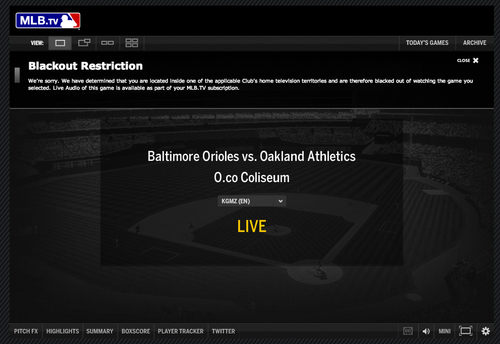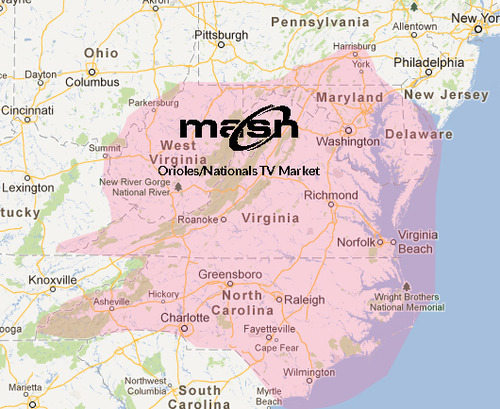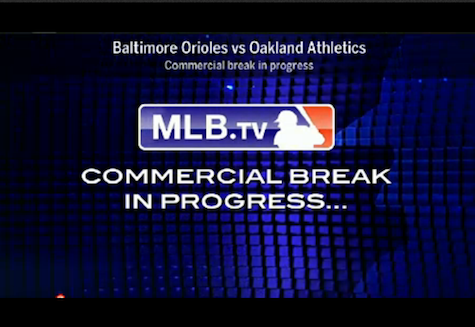Why I Hate MLB.TV & MASN
UPDATE 06/16/16: I received a response from the Heffler Claims Group. They confirmed that the settlement only requires the MLB to reach an agreement with Comcast, Root Sports, and Fox only. But it's not limited, they could pursue others.
Here's their reply in full:
Thank you for contacting Heffler Claims Group. The requirements for in-market streaming are for MLB to reach agreements with just Comcast, Root Sports and Fox, but they are not limited to only these companies.
UPDATE 06/09/16: The MLB/MLB.TV settled a class action lawsuit in January 2016 that begins to alleviate some of the issues I outlined in this post. The immediate impact is some price relief and a new "Single-Team Package", which allows fans to subscribe to watch only their favorite team's broadcast for $84.99/season. Unfortunately, in-market blackout rules still apply.
In my opinion, the biggest potential shake up from this settlement is that the MLB/MLB.TV will seek agreements with local sports networks to offer packages for in-market fans in 2017. The settlement states that if they don't have agreements by 2017, they can't raise prices until 2020.
The settlement's website only refers to teams who are covered by Comcast, Root Sports, and Fox regional sports networks. That makes it sound like a sports network like MASN (Mid-Atlantic Sports Network) is not included. For clarification, I sent an inquiry through the settlement website's contact form. I'll update this post if I receive a response.
I’m the ideal MLB fan and consumer. I purchase my favorite team’s swag, attend several games per season, read countless blogs, and pay for premium services like MLB.TV.
Come to think of it, a good portion of my income and time is spent on MLB related activities.
Each time I go to spend money on various MLB-related items, I start realize how broken their model is. It’s fascinating how much money the MLB and other professional leagues, sports networks, cable providers and their respective franchises are leaving on the table to maintain the status quo.
Through my own experiences as a fan, below are examples of why the MLB and its media partners are taking advantage of fans. These examples are only directly applied to MLB.TV and Mid-Atlantic Sports Network (MASN) who have the television rights to the Baltimore Orioles and Washington Nationals.
MLB.TV Blackout Restrictions - The Remote Fan
I currently live in San Francisco, but I’m a huge Baltimore sports fan. I’m 24 years old and understand the Internet, so any content I want to watch is readily available online. I don’t want or need a cable subscription. I'm a cable cutter.
But I still pay a lot for my entertainment. Hence my current media subscriptions:
- Netflix - $7.99/mo
- Rdio - $9.99/mo
- MLB.TV Premium - $24.99/mo during season
- Xbox Live - $9.99/mo
I also watch my fair share of WatchESPN, but I use my parent’s cable subscription credentials to watch “locked” events. The same is true with HBO GO. I should use this time to make ESPN and HBO aware that everyone of my friends is also doing this. I’m sure you know it. You must know it.
My Baltimore Orioles have spent this weekend in Oakland playing a 4-game series against the A’s. I consider myself a dedicated fan, so I gladly went to the Friday night game to cheer them on.
For the other three games, I’ll have to watch them at home while I take care of some work, do my laundry, and click refresh on my Twitter feed. You know, things a responsible twenty-something does.
So I fire up my MLB.TV around game time, and I’m faced with this message:

Oh no, the dreaded Blackout Restriction message. Since I’m attempting to watch the Orioles-A’s game in the A’s TV market, the game is not available through MLB.TV. So now I’m forced to watch the game on cable with the subscription I don’t have. Even worse, I have to watch the opposing team’s broadcast.
Fan Tip: Don’t worry, there’s plenty of free “unofficial” places to watch the game. Ironically, the stream’s source is someone streaming their MLB.TV account.
Since the local sports networks, MLB, and cable providers can’t seem to agree on terms that could result in more revenue for them, the fans are left to suffer.
Looking at the Orioles schedule for 2013, it appears that almost 10% of their games will fall under the MLB’s Blackout Restrictions. This also includes those dreadful Saturday afternoon FOX national broadcasts. I assume that larger market teams would have more games fall under the blackout restrictions, because they have more nationally televised games.
As a fan and paying customer of MLB.TV, I receive 10% less of the service I pay full price for. You can even argue that full price is overpriced, but that’s a separate argument.
MLB.TV Blackout Restrictions - The Local/Regional Fan
For a local/regional Baltimore/Washington fan, MLB.TV is virtually useless. This is the most ironic and puzzling part of the service offering. Why go through all the trouble and cost of creating a service that the overwhelming majority of it’s target market can’t use?
If you’re an Orioles or Nationals fan living in the below areas, all games will be blacked out on MLB.TV:

I lived in Charlotte, North Carolina for a year, I had to deal with this nonsense.
Granting Access = More Revenue
The above restrictions would make sense if MLB, MASN, or Time Warner could prove that they lose revenue by allowing consumers access.
From my point of view, they lose revenue by not allowing access.
It’s a known fact that the number of cable subscribers is declining rapidly. Consumers like me are finding less of a need to purchase overpriced cable subscriptions.
I want to buy subscriptions to direct content that I want. I don’t need to pay for 700+ channels if I only watch a handful.
Unlike our leaders in government, when I bitch about something I like to provide possible solutions that could result in an agreement for everyone involved. Here’s a set of solutions for each party involved:
Dear Major League Baseball, Franchises:
You’re are doing so many positive things in the digital/tech space to enhance the fan experience. The team at MLB Advanced Media does a great job with social media, online fan engagement, and more. In my opinion, they are the best professional sports league when it comes to digital media.
But why aren’t you pushing the sports networks and cable providers to follow you? You’ve created additional opportunities for revenue streams for all of you but have not capitalized on them.
When I’m watching a MASN telecast of an Orioles game on MLB.TV, this is the message I see when there is a break in the action:

This is absolutely hilarious. Why aren’t you, your advertisers, the sports network, or cable provider trying to sell me shit?
Update: There are advertisements during game breaks, but I only counted two over the course of a 3-hour game. Two of the same ads over and over. They were national ads from Microsoft and Old Spice, not targeted at all.
You have so much more data on me than a cable provider does. You could know what device I’m watching the game on, where I’m watching the game, what teams I like to watch, or how long I watch in a session. Use those demographics to sell me shit. Tell advertisers that you can give them a much larger ROI because of the information you have.
Through this added revenue stream, you could decrease the cost of your service. That could mean more subscribers, or more inventory to sell to advertisers.
Dear Mid-Atlantic Sports Network (MASN):
I like your telecasts, I really do. But you do such a great job of not allowing fans to view your content.
You refuse to allow local/regional Orioles and Nationals fans to watch your telecasts on the devices they use all day. I guess you’re just content with taking a percentage of cable subscribers’ bill every month.
You’ve been fighting with Time Warner in North Carolina for years. Why are you fighting over the opportunity to reach more fans? Do more fans mean more advertisement revenue? Do you want more subscribers that unknowingly pay a percentage of their cable bill to you - even if they never turn on your channel?
You televise two teams that are a part of Major League Baseball, and the MLB has paid millions of dollars to allow fans to watch your games on the go. They paid for the technology, but you don’t seem to be interested in providing the content to the majority of your target market.
Wouldn’t it be cool to tell your advertisers that they could reach fans that watch the game on their laptops, smartphones and tablets?
Please explain to me how you lose revenue by providing access to your telecasts through these new platforms. I don’t see how it’s possible.
Dear Cable Providers:
You are the reason why all of this continues to happen. If an entrepreneur’s business model is deteriorating, they innovate and create new revenue streams to remain successful.
Instead, you cowards elect to use your influence to slow down progress and innovation. You’re the ones who deserve to lose. You don’t create your own content, nor do you provide any real value anymore. So why do we need you?
We don’t.
In this day and age, companies that provide access to content must also produce content to survive. Netflix is a perfect example of this.
So I don’t have a solution for you. All things must come to an end. It’s your turn. Please go die with dignity.
And finally, the fans:
As fans, we need to stand up for ourselves. We're the fuel that runs the entire machine. We’re spending tons of money to support these clowns, yet we don’t ever make them earn it. We need to be more vocal about these inconveniences and demand change. This is my version of that.
It may not do anything, but this long venting session in the form of a blog post has made me feel better.

